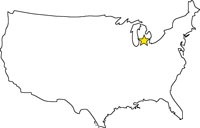Bollards – Not Just Sticks in the Mud
Posted by April L. on 28th Jun 2017
They come in an astounding array of designs and materials and serve a variety of purposes. Most of us see bollards on a daily basis but don't even realize it. Ever wonder what the deal is with those vertical posts that appear in practically all major cities?
Maritime Beginnings
The bollard started out in the 17th and 18th century as a short post on a quay, as well as its counterpart on a ship. They were used to secure the vessel to the harbor. In terms of design, they typically were larger near the top to prevent the dock lines from loosening. In fact, the term for a ship's towing power is called the " bollard pull."
While many bollards were made of wood or iron, sometimes they were repurposed old cannons, buried muzzle first into the ground; the rear end of the cannons protruded from the ground and ropes were tied to them. Some bollards in the 19th century were made to look like cannons.
Nowadays, bollards are better known as posts in the road to prevent cars from passing and are considered "street furniture."
Different Types of Bollards
Bollards are used to protect government compounds and similar high-security buildings, utilities, and retailers. They are a ubiquitous security design feature.
- A fixed bollard (also known as a static or permanent bollard) is made of concrete, metal, or wood and is either surface mounted or built into the ground.
- A rising or retractable bollard is activated to rise up from the ground or to retract into the ground via a controller, such as a remote. It can be electronic, pneumatic, or hydraulic and its function is to allow certain vehicles (emergency vehicles, delivery vehicles, and streetcars, for example) access, or to restrict access in certain situations (pedestrian-only paths and bridges, for example).
- A flexible bollard is usually made from plastic or rubber and can bend and return to its original position (i.e. is collapsible) if struck by a vehicle. It is designed to cause minimal damage to vehicles, not to physically bar vehicles from entering. They are intended to be more a visual guidance than anything else.
- A protective or security bollard is a steel post in concrete or other hard surface, buried, or otherwise secured, and is meant to protect buildings and people from a vehicle ramming attack and vehicle collisions. Some newer protective bollards are made to absorb some of the impact so there is less damage to the bollards, vehicles, and people inside the vehicle.
- A bell bollard is relatively short. As the name implies, it is shaped like a bell so that the wheel of a vehicle will roll around it. They are mostly used in areas with really tight turns.
Cultural and Artistic Bollards
In the City of Greater Geelong in Australia, one of the main attractions is the Baywalk Bollards along the Waterfront, with its 111 bollards, each connected to people or events in the history of Geelong. Commissioned by the city, artist Jan Mitchell transformed timber and other materials from a pier that had been demolished in the 80s into things/people like:
- Matthew Flinders, an English explorer
- a Portuguese explorer
- beachgoers from the 30s era
- Ian McDonald, a famous city surveyor
- a Koori family
Apparently, a number of these bollards have depictions of rabbits on them to commemorate the introduction of the rabbit to Australia on Christmas, 1859, when Thomas Austin released two dozen rabbits onto his property.
Definitely Not a Dumb Post
Bollards are possibly among the most underrated of traffic calming devices. Take a look at our selection of bollards, or contact us for more information.



